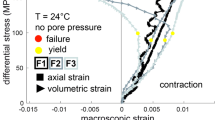Abstract
The methods and first results of a new approach to examining fault gouge are described. Samples of undisturbed fault gouge from the exhumed Lopez fault zone in the San Gabriel Mountains, California were impregnated with low viscosity epoxy resin and sectioned to produce microscope slides. The slides were photographed using optical and electron microscopy with magnifications ranging in factors of 2 from 12.5 to 1600. At all scales, the particles appeared angular with planar faces, suggesting tensile failure. No shear zones were discernable. The particle size distribution was studied. At each magnification the particles were sorted by diameter into four classes, differing in mean diameter by factors of 2. The numbers in each class were then scaled by the characteristic class dimension. The process revealed a remarkable degree of self-similarity. Over the range examined, the fractal dimension was within 5% of 2.60.
On the basis of the observations, a new model for the mechanical processes that generate gouge is offered. It is argued that self-similarity results from repeated tensile splitting of grains. Unlike earlier models that consider splitting probability to be either independent of particle size or due to the preexisting distribution of defects, we propose that failure probability depends largely on the relative size of nearest neighbors. If nearest neighbors of the same size are preferentially broken, any initial distribution of particles will tend toward a self-similar distribution having a fractal dimension of 2.58.
The model allows us to outline a procedure whereby the observed comminution in a fault zone can be related to the shear strain that the zone has accommodated and propose a theoretical frequency magnitude relation for the seismic energy emitted by the fracture process.
Similar content being viewed by others
References
Anderson, J. L., Osborne, R. H. andPalmer, D. F. (1982),Petrogenesis of cataclastic rock within the San Andreas fault zone of southern California. Tectonophysics67, 221–249.
Blandford, R. R. (1975),A source theory for complex earthquakes. Bull. Seism. Soc. Am.65, 1385–1405.
Engelder, J. T. (1974),Cataclasis and the generation of fault gouge. G.S.A. Bull.85, 1515–1522.
Epstein, B. (1947),The mathematical description of certain breakage mechanisms leading to the logarithmico-normal distribution. J. of the Franklin Institute244, 471–477.
Falconer, K. J. (1985),The geometry of fractal sets. Cambridge University Press, Cambridge, England.
Gilvarry, J. J. (1961),Fracture of brittle solids, I.Distribution function for fragment size in single fracture (theoretical). J. Appl. Phys.32, 391–399.
Gilvarry, J. J. (1964),Distribution of fragment size in repetitive fracture of brittle solids. Solid State Communications2, 9–11.
earthquake sources. Bull. Seism. Soc. Am.63, 2091–2104.
Gilvarry, J. J., andBergstrom, B. H. (1961),Fracture of brittle solids. II.Distribution function for fragment size in single fracture (experimental). J. Appl. Phys.32, 400–410.
Gilvarry, J. J. andBergstrom, B. H. (1962),Fracture of brittle solids, III. Experimental results on the distribution of fragment size in single fracture. J. Appl. Phys.33, 3211–3213.
Jaeger, J. C. andCook, R. G. W. (1979),Fundamentals of rock mechanics. Halsted Press, New York.
King, G. (1983),The accommodation of large strains in the upper lithosphere of the Earth and other solids by self-similar fault systems: the geometrical origin of b-value. PAGEOPH121, 761–815.
Molnar, P. (1983),Average regional strain due to slip on numerous faults of different orientations. J. Geophys. Res.88, 6430–6432.
Molnar, P., Tucker, B. E. andBrune, J. N.,Corner frequencies of P and S waves and models of earthquake sources. Bull. Seism. Soc. Am.63 2091–2104.
Olgaard, D. L. andBrace, W. F. (1983),The microstructure of gouge from a mining-induced seismic shear zone. Intl. J. Rock Mech. Min. Sci. and Geomech. Abstr.20, 11–19.
Robertson, E. C. (1982),Continuous formation of gouge and breccia during fault displacement, InIssues in rock mechanics (ed. Goodman, R. E. and Heuzel, F. E.) A.I.M.M.P.E., New York.
Sammis, C. G., Osborne, R. H., Anderson, J. L., Bandert, M., andWhite, P. (1986),Self-similar Cataclasis in the formation of fault gouge, PAGEOPH,124, 53–78.
Sammis, C. G. andOsborne, R. H. (1982),Textural and petrographic modal analysis of gouge from a depth of 165 m in the San Andreas fault zone (abst.). EOS63, 1109.
Turcotte, D. L. (1986),Fractals and fragmentation. J. Geophys. Res.91, 1921–1926.
Underwood, E. E. (1968),Particle size distribution, In DeHoff, R. T. and Rhines, F. N.,Quantitative microscopy. McGraw-Hill, New York, pp. 151–201.
Wilcox, R. E., Harding, T. P. andSeely, D. R. (1973),Basic wrench tectonics. A.A.P.G. Bull.57, 74–96.
Wilson, E. B. Jr. (1952),An introduction to scientific research. McGraw Hill, New York.
Wu, F., Blatter, L. andRobertson, H. (1975),Clay gouges in the San Andreas fault system and their possible implications. PAGEOPH113, 87.
Author information
Authors and Affiliations
Rights and permissions
About this article
Cite this article
Sammis, C., King, G. & Biegel, R. The kinematics of gouge deformation. PAGEOPH 125, 777–812 (1987). https://doi.org/10.1007/BF00878033
Received:
Revised:
Accepted:
Issue Date:
DOI: https://doi.org/10.1007/BF00878033




